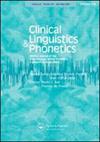Comprehension of verb morphology in Arabic-speaking children with and without developmental language disorder.
IF 1
4区 医学
Q4 AUDIOLOGY & SPEECH-LANGUAGE PATHOLOGY
引用次数: 0
Abstract
Children with developmental language disorder (DLD) experience difficulties with a range of morphosyntactic skills, particularly with tense and subject - verb agreement. Many studies have examined verb-morphology production in children with DLD. We extend this line of research by profiling verb-morphology comprehension in 67 monolingual Saudi Arabic-speaking children, comprising 33 with DLD (M = 61 months, SD = 10.70), and 34 age-matched typically developing (TD) children (M = 63 months, SD = 8.94). Children completed a novel picture selection task developed to assess their comprehension of verb tense, gender agreement, and number agreement. Children with DLD scored significantly lower than TD children on the verb morphology comprehension task. They showed greater difficulty identifying verb tense forms, particularly future tense. They also demonstrated lower accuracy in identifying subject-verb agreement in general, with specific difficulty in comprehending masculine verbs, and singular verbs. These findings were compared with production verb-morphology data from previous Arabic studies. Overall, this study highlights the challenges experienced by Arabic-speaking children with DLD in comprehending verb morphology, particularly tense and subject-verb agreement inflections. These findings can be used to tailor appropriate assessment designs and interventions for an Arabic-speaking DLD population.患有和未患有语言发育障碍的阿拉伯语儿童对动词词形的理解。
发育性语言障碍(DLD)儿童在一系列形态句法技能方面都存在困难,尤其是在时态和主谓一致方面。许多研究都对发育性语言障碍儿童的动词形态生成进行了调查。我们扩展了这一研究方向,对 67 名单语沙特阿拉伯语儿童的动词形态理解能力进行了分析,其中包括 33 名患有 DLD 的儿童(男 = 61 个月,女 = 10.70)和 34 名年龄匹配的典型发育(TD)儿童(男 = 63 个月,女 = 8.94)。儿童们完成了一项新颖的图片选择任务,该任务旨在评估他们对动词时态、性别一致和数字一致的理解能力。在动词词形理解任务中,DLD 儿童的得分明显低于 TD 儿童。他们在识别动词时态形式,尤其是未来时态方面表现出更大的困难。他们识别主谓一致的准确率也普遍较低,在理解阳性动词和单数动词方面尤其困难。这些研究结果与以往阿拉伯语研究中的动词形态学数据进行了比较。总之,本研究强调了讲阿拉伯语的 DLD 儿童在理解动词形态,特别是时态和主谓一致转折方面所遇到的挑战。这些发现可用于为讲阿拉伯语的 DLD 群体量身定制适当的评估设计和干预措施。
本文章由计算机程序翻译,如有差异,请以英文原文为准。
求助全文
约1分钟内获得全文
求助全文
来源期刊

Clinical Linguistics & Phonetics
AUDIOLOGY & SPEECH-LANGUAGE PATHOLOGY-REHABILITATION
CiteScore
2.70
自引率
16.70%
发文量
74
审稿时长
6-12 weeks
期刊介绍:
Clinical Linguistics & Phonetics encompasses the following:
Linguistics and phonetics of disorders of speech and language;
Contribution of data from communication disorders to theories of speech production and perception;
Research on communication disorders in multilingual populations, and in under-researched populations, and languages other than English;
Pragmatic aspects of speech and language disorders;
Clinical dialectology and sociolinguistics;
Childhood, adolescent and adult disorders of communication;
Linguistics and phonetics of hearing impairment, sign language and lip-reading.
 求助内容:
求助内容: 应助结果提醒方式:
应助结果提醒方式:


